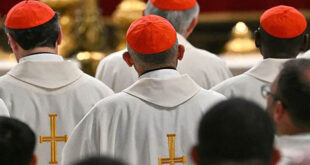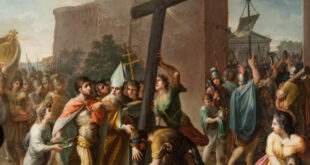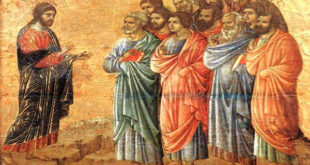A Sign Lost in Time
If you attend Mass today, you may notice the priest breaking the Host before Communion. It may seem like a simple practical action, but in the Tradition of the Church, this act held deep and symbolic meaning. In the traditional liturgy, before Communion, the priest would break the consecrated Host into three parts. This rite, known as the Breaking of the Bread, was more than just a liturgical movement—it revealed the mystery of the Holy Trinity and the communion of the faithful in Christ.
However, with liturgical reforms and changes in the way Mass is celebrated in many parishes, this rite has been minimized or nearly forgotten. What have we lost as a result? Why was the breaking of the Host so important? And most importantly, how can we rediscover its profound significance for our spiritual lives today?
The Breaking of the Bread in the Early Church: An Act of Unity
From Apostolic times, the Breaking of the Bread was the name early Christians used to refer to the Eucharist. In the Acts of the Apostles, we read:
“They devoted themselves to the apostles’ teaching and to fellowship, to the breaking of bread and to prayer.” (Acts 2:42)
This expression not only referred to the physical action of breaking the bread but also to the mystical reality of the faithful’s communion in the Body of Christ. The bread, which represented Christ, was broken and shared among all, reflecting the unity of the Church in Him.
In the first centuries, this gesture was even more visible because the Eucharist was celebrated with unleavened bread that was broken into pieces to be distributed among the faithful. This breaking was not merely functional; it was an act that made present the unity of Christ’s Body in the Church.
The Rite in the Traditional Mass: Three Parts, One Body
As the liturgy developed, the Breaking of the Bread became a rite rich in theological meaning. In the traditional Mass, before Communion, the priest would take the consecrated Host and break it into three parts:
- One part remained on the paten.
- Another part was placed in the chalice with the Blood of Christ.
- The last part was consumed by the priest.
This gesture was not accidental. Each part had a deep meaning:
- The Holy Trinity: The triple division of the Host represented the three Divine Persons in one God.
- Christ, the Victim and Redeemer: The breaking of the Host evoked Christ’s sacrifice on the Cross, whose body was “broken” for us.
- The Unity of the Faithful: By uniting a fragment of the Host with the chalice, it expressed the reality that Christ is inseparable in His Body and Blood, just as the faithful must remain united in Him.
This rite was accompanied by a very significant prayer: “Pax Domini sit semper vobiscum” (“The peace of the Lord be with you always”). This was not just a simple greeting but a proclamation that true peace comes only from Christ, whose real presence was made manifest in the Eucharist.
Why Has This Gesture Been Lost?
With the liturgical reform following the Second Vatican Council, the emphasis on certain visible signs was reduced. In many modern celebrations, the breaking of the Host is almost imperceptible, and its symbolic meaning has been forgotten.
Some reasons for this change include:
- The simplification of the liturgy to make it more accessible.
- The introduction of new practices, such as the use of small hosts for Communion, which made breaking the Host unnecessary.
- A shift in Eucharistic theology, which emphasized the communal meal aspect more than the redemptive sacrifice.
However, by losing this gesture, we have also lost a visible reminder of the mystery of the Eucharist and our communion in Christ.
Rediscovering the Breaking of the Bread in Our Spiritual Life
Although the Breaking of the Bread has been minimized in many parishes, we can rediscover its spiritual richness and apply it to our Christian life.
- Living Unity in Christ: The Eucharist is not just an individual act; it unites us as members of one Body. We must live this unity in our daily lives, avoiding division and seeking communion with our brothers and sisters in faith.
- Remembering Christ’s Sacrifice: The breaking of the Host reminds us that Christ gave Himself for us. Our Christian life should be a response of love and sacrifice, offering our time and talents in service to others.
- Deepening Our Understanding of the Traditional Mass: Knowing the traditional liturgy helps us rediscover signs and gestures that enrich our understanding of the Eucharistic mystery. Even if we attend the modern form of the Mass, we can learn from Tradition to live the Eucharist more deeply.
Conclusion: A Gesture We Need to Recover
The rite of the Breaking of the Bread is not just a liturgical detail from the past. It is a sign that reminds us of the unity of the Church, the redemptive sacrifice of Christ, and the real presence of God among us.
If we want to revitalize our spiritual lives and live the Eucharist more fully, we must recover the deep meaning of these gestures. When we see the Host being broken, let us remember that in Christ, we are called to be one, just as He is one with the Father and the Holy Spirit.
The next time you participate in the Holy Mass, observe this gesture with new meaning. And when you receive Communion, do so with the certainty that you are part of a Body united in Christ, awaiting the day when we will be gathered with Him in the eternal communion of Heaven.
May this forgotten sign be for us a call to unity, love, and total surrender to Christ!






